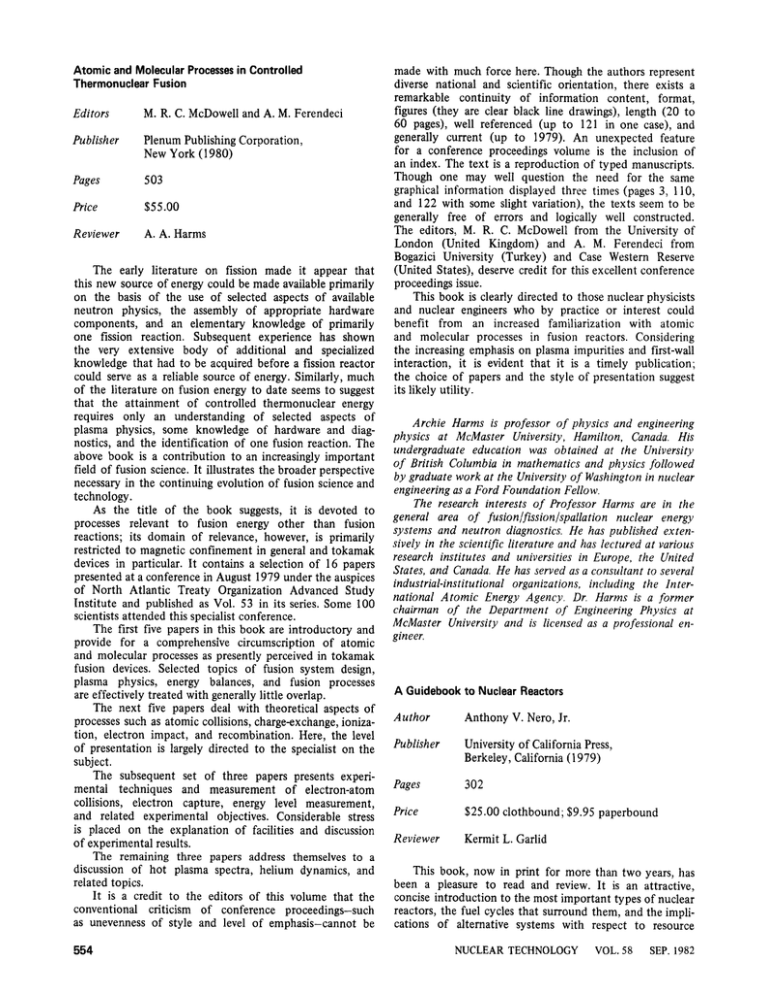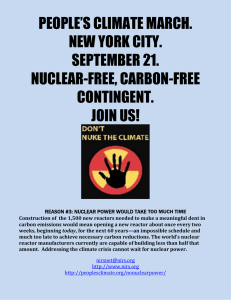Editors M. R. C. McDowell and A. M. Ferendeci Publisher Plenum
advertisement

Atomic and Molecular Processes In Controlled Thermonuclear Fusion Editors M. R. C. McDowell and A. M. Ferendeci Publisher Plenum Publishing Corporation, New York (1980) Pages 503 Price $55.00 Reviewer A. A. Harms The early literature on fission made it appear that this new source of energy could be made available primarily on the basis of the use of selected aspects of available neutron physics, the assembly of appropriate hardware components, and an elementary knowledge of primarily one fission reaction. Subsequent experience has shown the very extensive body of additional and specialized knowledge that had to be acquired before a fission reactor could serve as a reliable source of energy. Similariy, much of the literature on fusion energy to date seems to suggest that the attainment of controlled thermonuclear energy requires only an understanding of selected aspects of plasma physics, some knowledge of hardware and diagnostics, and the identification of one fusion reaction. The above book is a contribution to an increasingly important field of fusion science. It illustrates the broader perspective necessary in the continuing evolution of fusion science and technology. As the title of the book suggests, it is devoted to processes relevant to fusion energy other than fusion reactions; its domain of relevance, however, is primarily restricted to magnetic confinement in general and tokamak devices in particular. It contains a selection of 16 papers presented at a conference in August 1979 under the auspices of North Atlantic Treaty Organization Advanced Study Institute and published as Vol. 53 in its series. Some 100 scientists attended this specialist conference. The first five papers in this book are introductory and provide for a comprehensive circumscription of atomic and molecular processes as presently perceived in tokamak fusion devices. Selected topics of fusion system design, plasma physics, energy balances, and fusion processes are effectively treated with generally little overlap. The next five papers deal with theoretical aspects of processes such as atomic collisions, charge-exchange, ionization, electron impact, and recombination. Here, the level of presentation is largely directed to the specialist on the subject. The subsequent set of three papers presents experimental techniques and measurement of electron-atom collisions, electron capture, energy level measurement, and related experimental objectives. Considerable stress is placed on the explanation of facilities and discussion of experimental results. The remaining three papers address themselves to a discussion of hot plasma spectra, helium dynamics, and related topics. It is a credit to the editors of this volume that the conventional criticism of conference proceedings-such as unevenness of style and level of emphasis-cannot be made with much force here. Though the authors represent diverse national and scientific orientation, there exists a remarkable continuity of information content, format, figures (they are clear black line drawings), length (20 to 60 pages), well referenced (up to 121 in one case), and generally current (up to 1979). An unexpected feature for a conference proceedings volume is the inclusion of an index. The text is a reproduction of typed manuscripts. Though one may well question the need for the same graphical information displayed three times (pages 3, 110, and 122 with some slight variation), the texts seem to be generally free of errors and logically well constructed. The editors, M. R. C. McDowell from the University of London (United Kingdom) and A. M. Ferendeci from Bogazici University (Turkey) and Case Western Reserve (United States), deserve credit for this excellent conference proceedings issue. This book is clearly directed to those nuclear physicists and nuclear engineers who by practice or interest could benefit from an increased familiarization with atomic and molecular processes in fusion reactors. Considering the increasing emphasis on plasma impurities and first-wall interaction, it is evident that it is a timely publication; the choice of papers and the style of presentation suggest its likely utility. Archie Harms is professor of physics and engineering physics at McMaster University, Hamilton, Canada. His undergraduate education was obtained at the University of British Columbia in mathematics and physics followed by graduate work at the University of Washington in nuclear engineering as a Ford Foundation Fellow. The research interests of Professor Harms are in the general area of fusion!fission Ispallation nuclear energy systems and neutron diagnostics. He has published extensively in the scientific literature and has lectured at various research institutes and universities in Europe, the United States, and Canada. He has served as a consultant to several industrial-institutional organizations, including the International Atomic Energy Agency. Dr. Harms is a former chairman of the Department of Engineering Physics at McMaster University and is licensed as a professional engineer A Guidebook to Nuclear Reactors Author Anthony V. Nero, Jr. Publisher University of Cahfomia Press, Berkeley, California (1979) Pages 302 Price $25.00 clothbound; $9.95 paperbound Reviewer Kermit L. Gariid This book, now in print for more than two years, has been a pleasure to read and review. It is an attractive, concise introduction to the most important types of nuclear reactors, the fuel cycles that surround them, and the implications of alternative systems with respect to resource requirements, environmental effects, and the risk of diversion of nuclear materials. It is well written, nicely laid out, and supplemented with tables and schematics, and compiles into a single volume useful information on design and process characteristics of most of the reactors in use or contemplated for the near future. As its title implies, the book is intended as a general guide rather than a detailed, exhaustive reference work. The author's stated purpose was to describe reactors as they exist and "to indicate the basic forms that nuclear systems may take in the future." Background information on reactor safety, alternative fuel cycles, waste disposal, and design compromises is also included. The book should be helpful to all those—students, faculty, and informed citizenry alike—who are interested in having at their disposal a basic guide to nuclear systems. It was not intended and would not serve well as a textbook, but might be very useful to students both in courses on energy systems and in introductory and advanced nuclear engineering courses. As a reference, it provides a collection of reactor system data and schematics that is usually found only in a less consistent form and in widely scattered reports. Three Mile Island occurred after the book was published in 1979. Although developments since that time are therefore not included, the timing may have been a blessing in disguise. As it stands, safety issues are given a prominent position and a balanced treatment. If it had been written later, however, the temptation to discuss TMI to the exclusion of other safety dimensions may have been too strong to overcome. While it is not particularly colorful, the author's writing is clear and informative and the small number of errorsboth in factual material and in proofreading—shows an appreciation for quality and attention to detail. Some may not share Dr. Nero's fondness for parenthetical comments or quotation marks to explain or set off rather common terms, but this is a minor point. Selection of the range and type of material to be included, always difficult in developing a general guide, is good, with a nice balance between the quantitative, the illustrative, and the narrative. There are four main sections: A General Introduction to Nuclear Reactors; Commercial Nuclear Reactors; Uranium Resources, Advanced Fuel Cycles, and Nuclear Materials; and Advanced Reactor Systems-Breeders, Near-Breeders, and What-Not. Appendixes include sections on abbreviations and units, nuclear physics data, characteristics of nuclear materials, energy conversion systems, nuclear criticality and control, and the nuclear fuel cycle. A glossary of terms is also provided. Fusion and fission-fusion systems are mentioned, but only briefly. In summary, A Guidebook to Nuclear Reactors is a nonpolemic, informative book, intelligently conceived and written. It succeeds admirably in achieving its objectives and, given the rate at which nuclear reactor systems are evolving, should be useful for many years. Kermit Garlid is professor of nuclear engineering and chemical engineering at the University of Washington in Seattle. In recent years he has also served as associate and acting dean of the University's College of Engineering, and has been a senior visiting scientist at laboratories and universities in Norway, Germany, and Switzerland. His principal research interests are in nuclear fuel cycles and nuclear reactor safety. Hazardous Waste Management Author J. Jeffrey Peirce and P. Aarne Vesilind Publisher Butterworths, Woburn, Massachusetts (1981) Pages 186 Price $29.95 Reviewer A. Keith Furr This book represents the material presented at a conference on hazardous waste management that took place at Franklin Pierce College in August 1980. It is interesting to note the ideas that were presented at that time and compare them to the developments that have taken place since. I enjoyed reading the book but I do not believe it will be of any great value to those for which it is purported to be published, namely, engineers in various work situations. The book is divided into three sections: Problems in Hazardous Waste Management, Technological Inputs to the Management Process, and Case Studies in the Management of Hazardous Waste. Much of the first section is concerned with presenting and interpreting the terms of the Resource Conservation and Recovery Act and does so adequately. However, much of the material is available from Environmental Protection Agency publications. The paper in this section by George W. Pearsall, "Decision-Making in Hazardous Waste Disposal," was, I felt, unusually well done and provocative. The author first discusses the preliminaries to the final stage, the decision of "what to do?" These initial stages consist of identification of the problems, value judgment, hazard assessment, and determination of options. These areas were well developed. However, it is the discussion of the decision-making process that represents the really significant contribution of this paper. In this section, he describes ethical decision-making strategies. In his concluding paragraphs, the author raises the question of what value is a knowledge of these ethical considerations and 1 felt he answered himself very well. "I think the principal purpose of such knowledge is to sensitize the decision-maker to the values underlying his/her decisions." As I read this section, I recognized myself and many of the individuals with whom I work. It was enlightening. The second portion of the book comes closest to meeting the stated purpose of the book. Basically it consisted of papers presented by various individuals involved in disposal operations and covers incineration technology, landfill siting, design, monitoring, and management. It touches briefly on some of the economic and political issues as well. A brief description of the super fund is included in this section but there have been a number of legislative changes in this area. The last section consists of three case histories involving hazardous waste, although in fact the last of these really is a description of an industrial accident, resulting in contamination of the environment. Although interesting and, indirectly, providing information as to the procedures to be followed when hazardous materials are found to pose a risk to the public, I did not feel that the information to be gleaned from this section justified taking up 40% of the book.
